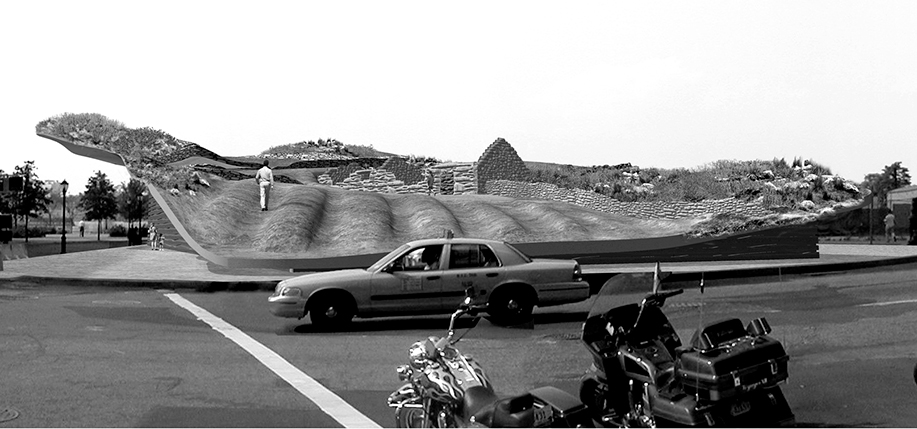Plans for a half-acre, $4.7-million Irish Hunger Memorial commemorating victims of the Great Hunger and those who immigrated to the United States, were unveiled in New York City on March 15. The year-long project is being funded by the Battery Park City Authority. Governor George Pataki; Mayor Rudy Guiliani; Michael Martin, Ireland’s Minister of Children and Health; Northern Ireland Minister of Education Martin McGuinness, and state and city officials participated in the groundbreaking.
“The site will include a ruined cottage, deserted potato furrows, uncultivated land and a high wall of alternating layers of stones and illuminated glass depicting contemporaneous personal, official, and media accounts of the famine,” said collaborating architect Juergen Riehm. “It’s not a garden…it’s a fragment, not a rendition of the famine’s devastation on the Irish landscape.”
Brian Tolle, the artist selected for his winning design, visited the deserted Achill Island village of Slievemore before submitting his plans. “It was apparent at that time that this was about absence, (that the village was) deserted as a result of famine, and I wanted to make the land a subject and point to its tragedy,” he said of the former 70-dwelling village. “Everything is true to what it was,” the internationally exhibited artist said of his memorial.
“Brian’s presentation was a wow, and the Executive Committee embraced it unanimously,” said James Gill, chairman of Battery Park City Authority. “It’s like a piece of Ireland right here. It’s a living thing, not just brick and mortar, and will also serve as a catalyst for addressing issues of world hunger. The timing of the unveiling and projected finished date, March 2002, were deliberate, as both St. Patrick’s Day and the memorial’s subject are Irish events,” Gill added.
“I’m Irish – you have to be Irish to be a mayor of this city,” said Guiliani, joking, “and New York is the city it’s become because of the Irish. There can’t be a more appropriate way to begin St. Patrick’s Day then with this serious reflection, and the memorial’s location close to the Statue of Liberty couldn’t be more suitable,” he said.
“The memorial illustrates how high the Irish are held in this city…the important design manages to capture an old landscape and the real impact the famine had on communities – you can still see some of those villages today,” said Michael Martin, who was representing the Irish government at St. Patrick’s Day celebrations in New York City.
“I think it’s unbelievable – to see what will be a field in the middle of Manhattan,” said Martin McGuinness, before joining the approximately 25 dignitaries for the groundbreaking. He added that the project was a tremendous tribute to everyone involved and a reflection of the work Irish Americans have made to the Northern Ireland peace process. ♦


My latest book, THE GREAT HUNGER (1845-1852) & ITS LEGACY IN AMERICA: THE ORPHAN TRAIN ERA (1853-1929) is available from LGT Press or by calling 845-300-4296. I lecture extensively in the Northeast and would be happy to do a lecture/video at THE IRISH HUNGER MEMORIAL. I have written five books on the Orphan Train Era.